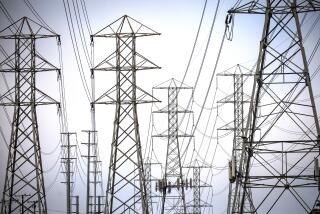Downed power lines: a fiery culprit only money can stop
Power lines are the suspected culprit behind at least five of the 12 major fires that burned in Southern California last week, including the Witch fire, which burned nearly 200,000 acres, destroyed 1,041 homes and killed two people.
Although acts of arson generate public outrage and police action, power lines pose a thorny problem with no easy solution: Should utilities do more to prevent failures, particularly in wild-land areas prone to high wind? And are ratepayers willing to pay the bill?
“The utilities and the public sector need to come to the mountain and realize there is an issue here that needs to be addressed,” said Los Angeles County Supervisor Zev Yaroslavsky. “It’s almost like a taboo subject.”
High-voltage lines can start fires when they cross, touch tree branches or hit the ground, causing the electrical current to arc in explosions of sparks.
When Yaroslavsky visited the scene of the Canyon fire in Malibu, it struck him how often he had heard of downed power lines sparking fires in the Santa Monica Mountains during heavy winds. He sponsored a motion, which supervisors approved Tuesday, to have county staff work with Southern California Edison to research ways to lower the risk of power line ignitions in fire-prone areas.
“This is an issue that has gone un-addressed for decades,” he said.
State regulators require utilities to clear brush and meet pole strength standards to help prevent downed power lines. But they say the only sure-fire way to remove the fire threat is to replace overhead lines with underground ones.
Both Southern California Edison and San Diego Gas & Electric say that would cost a minimum of $1 million a mile. And in remote, rocky areas, the cost soars from that baseline.
Edison alone has more than 70,000 miles of overhead lines in its 50,000-square-mile service area, which covers all or parts of 11 counties in Southern and Central California.
Some money is set aside by regulators to bury lines, but the funds fall far short of the need.
Edison is expected to collect $3.5 million throughout Los Angeles County in 2007 for placing overhead lines underground, according to spokesman Steven Conroy. “It’s up to the county, working with Edison, to identify the projects,” he said.
Utilities around the country are putting new power lines underground and replacing some overhead lines with subterranean ones.
But most of the buried lines are in residential areas where people didn’t want them marring their views, not in the wind-prone backcountry where a few sparks from a power line can turn brush into a raging monster.
Old overhead power lines still crisscross the grasslands and chaparral canyons of San Diego County’s Laguna Mountains, site of three of the six largest fires in California history: the Witch fire last month, the Cedar fire of 2003 and the Laguna fire in 1970.
Power lines were the cause in the Laguna fire. And there have been other near disasters.
Just a mile from where the Witch fire started, power lines fell in Santa Ana winds last November, sparking a fire that could have been devastating had firefighters not put it down so quickly.
Dave Geier, vice president of electrical transmission at SDG&E, said last month’s fires may change the equation of how authorities decide where to bury power lines.
“The question is: How can we do a better job in prioritizing some of these backcountry circuits in terms of undergrounding?” he said. “To this point, it’s been standard utility practice to have these lines in rural areas overhead.”
Southern California Edison has clashed with fire authorities in the past. In 1997, state officials investigating the 13,000-acre Calabasas-Malibu fire raided Edison’s headquarters in Rosemead.
The California Department of Forestry and Fire Prevention said at the time that the utility had repeatedly hindered investigations by withholding information or by removing evidence from the scenes of major fires. Edison denied the allegation.
Prosecutors ultimately concluded that Edison failed to trim trees around power lines that sparked the fire but that its negligence was not criminal.
The issue of power line fire safety has largely faded from public view since then. Part of the reason is that this type of fire is relatively rare.
Yet when power line fires occur, it’s often during high winds. And those fires can be particularly destructive.
In the Santa Monica Mountains, power lines sparked 8% of the fires since 1981, according to a University of Wisconsin study on fire ignition. But those fires were responsible for 24% of the total acres burned.
“They are rare events but extremely destructive when they occur,” said Joe Mitchell, a Ramona resident and scientist who has done extensive research on power line fires. Mitchell is working with the Sierra Club to oppose a major SDG&E transmission project, called the Sunrise Powerlink, that would cross the Laguna Mountains.
Of the 20 largest wildfires in California history, power lines were suspected or blamed for four, accounting for about 21% of the charred acreage, according to forestry department statistics.
It appears that power lines played an even larger role in last month’s devastation than they have historically. The fires linked to possible power line failures -- the Witch fire, the Canyon fire, the Rice fire near Fallbrook, the Ranch fire near Castaic and the Grass Valley fire in the San Bernardino Mountains -- collectively charred more than 271,000 acres and some 1,500 homes.
The California Public Utilities Commission is investigating each of the fires and will determine what, if anything, could have been done to avoid the failures, said Richard Clark, director of the utility’s consumer protection and safety division.
“All of this will be looked at,” he said.
Raffy Stepanian, program manager for utility safety at the California Public Utility Commission, said utilities can make overhead lines safer with concrete or metal poles, guy wires that anchor the poles to the ground and newer hardware.
Edison spokesman Conroy said the utility is looking closely at the failures of last month to see “what improvements can be made.”
“The system performed pretty well given we got reports of winds in excess of 100 miles per hour,” he said. “We have people who worked for the company for 25 years, and they haven’t seen winds this strong.”
As for putting the lines underground, ratepayers will ultimately have to decide if they’re willing to pay. “The utilities will underground any line if someone wants to pay for it,” Clark said.
More to Read
Sign up for Essential California
The most important California stories and recommendations in your inbox every morning.
You may occasionally receive promotional content from the Los Angeles Times.











